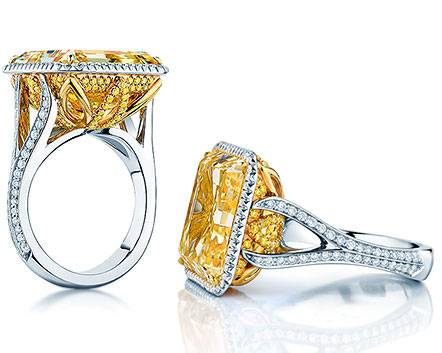Diamonds are an investment. That is a true statement. However, the meaning of that saying can be a bit misleading.
Diamonds do appreciate. As a matter of fact, according to CNBC, some diamonds have appreciated 20% each year for the past 20 years.
That’s right. I said “some diamonds.” Unfortunately, it most likely does not include yours.
“1 in 50 Diamonds Will Likely Appreciate”
CEO of Diamond Cutters International, Fred Cuellar, stated that “Only 1 of the 50 diamonds sold in 2010 will likely appreciate.” What makes that one stone different than the other diamonds? The simple answer is the rarity of that gem.
Like how most of the economy works, supply, and demand determines value. Exclusivity of a gem drives up its value. That is why the diamonds that appreciate most are the exotic ones that come in rare colors.
It’s hard to get, so we want it!
Wait, So We WANT Colored Diamonds?
When choosing our diamonds, we have been taught that colorless diamonds are the real deal. And that is a pretty safe bet. However, these are the ones that are going to be worth the same price as you paid when you attempt to resell it.
- Reds and pinks: the Irregular atomic structure is what makes these red and pink diamonds such a rarity. Light entering the gem excites electrons within the diamond to different wavelengths. This causes our eyes to interpret these ruby-like hues.
- Blues: Before you start seeking out an exorcist, the Hope Diamond Curse is just a myth. And there’s a reason why this gem is sitting in the Smithsonian. Blue diamonds are a true rarity as they get their colors from trace amounts of boron within the stone.
- Yellow: Yellow diamonds have been the measuring stick for diamonds without much value. Nitrogen gives colorless diamonds a yellowish hue, which is detrimental to its color grade.
However, it is important not to confuse this yellow with the very valuable canary-yellow diamond. They have a very high clarity rating. Combining such a strong score with its rare availability makes for a desirable appreciation value.
So STAY AWAY from THESE Colors
- Green: Radiation is the culprit in the creation of a diamond’s green hue. It is too hard for gemologists to determine if the hue created is man-made or done naturally. Inability to distinguish the difference essentially leaves your diamond value-less.
- Champagne, cognac or chocolate: These diamonds just sound like an aphrodisiac! They may have a name we associate with a delicacy, but these gems are in fact the most common diamonds of all. This hurts the whole supply and demand theory, doesn’t it?
You Should Still Love Your Diamond
You should not feel disappointed about purchasing the diamond that you have. It may not grow in appreciation with each passing year, but it has not lost its value either. You can most likely sell your diamond for around the same price that you bought it.
Diamonds are like many other investments where the value fluctuates, but it is not as up and down as other common investments, such as gold. As long as you continue to care for your diamond, it is still a valuable asset to have.
Rare and exotic colored diamonds do appreciate, but it may not be worth the investment. Real estate and businesses may be a more wise way to spend your money. However, if you do love the beauty of these rare colors, you have nothing to lose by adding them to your vault of valuables.

